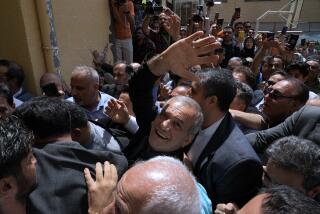Meetings Draw Tens of Thousands : Polemics, Calls for Blood Mark Prayers in Tehran
- Share via
TEHRAN — It is just past noon on a Friday and Hashemi Rafsanjani, the Speaker of Iran’s Parliament, or Majlis, is in the middle of a fiery speech denouncing this week’s downing of an Iranian airliner by Iraqi warplanes.
The crowd--tens of thousands gathered in a vast square at Tehran University for a prayer meeting, their fists raised in anger--interrupts with a shout: “O, our Majlis Speaker, revenge, revenge!”
“God willing, we will take our revenge,” Rafsanjani, one of the most powerful men in Iran, intones in reply.
A call for blood vengeance may seem to Western minds like an unusual theme for a religious sermon, but such topics are regular grist for these Friday prayer sessions, which have become an institution in Iran since the Islamic revolution toppled Shah Mohammed Reza Pahlavi in 1979. Such sessions played a significant role in the shah’s downfall because many mullahs, or religious leaders, throughout Iran used them to denounce the shah’s autocratic rule.
Wide-Ranging Sermons
While they are called prayer sessions, the weekly meetings actually consist of two lengthy sermons called khotba , in addition to two sets of formal prayers. Unlike sermons in the Christian sense, the Shia Muslim versions venture freely into the world of politics, international relations and war.
Perhaps the most prominent prayer session is the one held every Friday in the square at Tehran University, an area that before the revolution was the school’s soccer field.
Several thousand men--the women faithful are segregated behind a barrier--sit cross-legged in neat lines on brightly colored rugs as the speaker for the day gives his talk from a narrow booth at one end of the field.
At this Friday’s session, there are dozens of Iraqi war prisoners in gray jackets and shaved heads who shake their fists as animatedly as the Iranians nearby. Next to the prisoners sit Iranian war wounded who are confined to wheelchairs, blankets wrapped around their shoulders against the February chill.
The crowd is so large that it spills into the surrounding streets, where white lines have been painted on the pavement so that the faithful can sit facing in the direction of Mecca, as the Muslim religion requires.
Translucent Barrier
Women among the faithful are kept off to one side by a wall of translucent white sheeting. In their black chadors, shrouds that cover everything but the face, they seem like a colony of penguins when viewed through the surreal filter of the barrier.
The faithful sit in the open air, even in winter, although a forest of scaffolding remains from the summer months. Then the poles support tarpaulins that offer shelter against the withering sun, an essential precaution as these speeches tend to drag on for several hours. An indoor facility is being considered as a replacement for the open-air site at Tehran University.
Because the Friday prayer sessions have been the scene of bomb explosions by Iranian dissidents, each of the tens of thousands of people in attendance has been thoroughly searched. Streets are closed off for several blocks around the university, and guards with radios and guns are stationed throughout the crowd.
On this Friday, Rafsanjani, a particularly dramatic speaker, is dressed in a simple brown and black robe and a white turban. He wears a shirt with its collar open. Prime Minister Hussein Moussavi is in the second row of the faithful, kneeling in a brown suit.
While Rafsanjani is flanked by photographs of martyred mullahs, there are no pictures of the Ayatollah Ruhollah Khomeini, Iran’s supreme spiritual leader.
Portraits Removed
Khomeini, ever sensitive to the Koran’s injunction against graven images, and also trying to project an image of modesty, directed some months ago that his picture be taken down from every mosque in the country.
The crowd is already fired up by Iran’s strategic successes on the battlefield against Iraq in the past two weeks. Rafsanjani is interrupted several times by shouts of “Down with the U.S.A.!” which in Iranian terms has become the equivalent of saying “Amen.”
Range of Topics
In his speech, Rafsanjani ranges from domestic affairs--Iran’s internal enemies are providing information to the Iraqis, he says--to economic matters--Arab oil producers are driving down the price of oil to hurt Iran’s war efforts against Iraq, an Arab nation.
“Certain members of the Organization of Petroleum Exporting Countries have moved to collaborate with the world’s arrogants, against the best interests of OPEC,” he says, referring to the generally depressed prices on the world oil market.
When he calls on the country’s 3 million war volunteers to be ready to leave for the front, the crowd rises to its feet, shouting “Azim, azim (Mighty, mighty)!”
Behind the small speaker’s platform, several television trucks are parked, recording the sermon for broadcast during prime time hours Friday night. The speech is also transmitted live on the radio.
More to Read
Sign up for Essential California
The most important California stories and recommendations in your inbox every morning.
You may occasionally receive promotional content from the Los Angeles Times.













